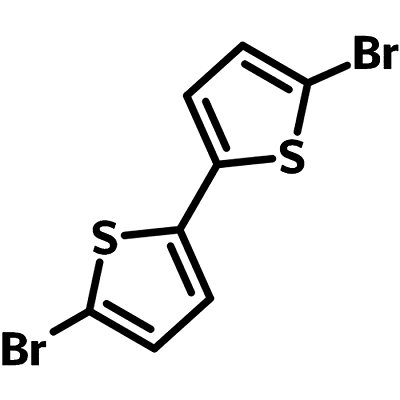5,5'-Dibromo-2,2'-bithiophene
CAS Number 4805-22-5
Chemistry Building Blocks, Dibromo Monomers, Heterocyclic Building Blocks, Materials, MonomersBuilding block for semiconducting small molecules, oligothiophenes and polymers
For the synthesis of a variety of materials for OLEDs, OFETs and organic solar cells
Specifications | MSDS | Literature and Reviews
5,5'-Dibromo-2,2'-bithiophene (CAS number 4805-22-5), a bromine functioned 2,2'-bithiophene at 5,5'-positions, is an important building block for the synthesis of a variety of semiconducting small molecules, oligothiophenes and polymers for use in OLEDs, OFETs and organic solar cells. The bromine functioned bithiophene is a key intermediate for Suzuki and Stille coupling reactions to form C-C bonds.
5,5'-Dibromo-2,2'-bithiophene can be copolymerised with 2,2'-(9,9-dioctyl-9H-fluorene-2,7-diyl)bis(4,4,5,5-tetramethyl-1,3,2-dioxaborolane) to afford a wide band gap conjugated F8T2. F8T2 is widely used in OLED devices, either as yellow emitter or as a polymer donor in blends with PCBMs in OPV devices. Photodetectors of nanocomposite thin films containing F8T2 and wide band gap ZnO nanoparticles (NPs) serving as the active layers exhibit a high external quantum efficiency of 782% at 358 nm under a low forward bias of 3 V, with the full-width at half-maximum of 16 nm. A high specific detectivity of 8.45 × 1012 Jones with a low dark current can be achieved.
p-Channel semiconductor 5,5′-bis-(7-dodecyl-9H-fluoren-2-yl)-2,2′-bithiophene (DDFTTF), prepared from the coupling reaction of 5,5'-Dibromo-2,2'-thiophene and 7-dodecyl-9H-fluoren-2-boronic acid, showed a mobility as high as 0.39 cm2/Vs and an on/off ratio of 2 × 105 in OFET devices. DDFTTF also exhibits excellent device performance resistant to harsh environments including aqueous conditions. With long alkyl side chains that promote molecular packing and water stability, DDFTTF based OTFT sensors can detect trinitrobenzene, methylphosphonic acid, cysteine, and glucose with concentrations as low as parts per billion (ppb) in aqueous solutions.
General Information
| CAS Number | 4805-22-5 |
| Chemical Formula | C8H4Br2S2 |
| Full Name | 5,5'-Dibromo-2,2'-bithiophene |
| Molecular Weight | 324.06 g/mol |
| Synonyms | 2,2'-Bi(5-bromothiophene) |
| Classification / Family | Bithiophene, semiconductor synthesis intermediates, low band gap polymers, OLED, OFETs, organic photovoltaics |
Chemical Structure

Product Details
| Purity | >98% (1H NMR in CDCl3) |
| Melting Point | 144.0 °C - 146.0 °C |
| Appearance | Solid powder |
MSDS Documentation
 5,5'-Dibromo-2,2'-bithiophene MSDS Sheet
5,5'-Dibromo-2,2'-bithiophene MSDS Sheet
Literature and Reviews
- Carbon based materials for electronic bio-sensing, Mater. Today, 14 (9), 424-433 (2011); DOI: 10.1016/S1369-7021(11)70187-0.
- Electronic structure, optical and structural properties of organic 5,5′-Dibromo-2,2′-bithiophene, M. Kurban et al., Optik, 165, 370-379 (2018); DOI: 10.1016/j.ijleo.2018.04.003.
- Narrowband Ultraviolet Photodetectors Based on Nanocomposite Thin Films with High Gain and Low Driving Voltage, E. Zheng et al., ACS Appl. Mater. Interfaces, 10 (48), 41552–41561 (2018); DOI: 10.1021/acsami.8b13575.
